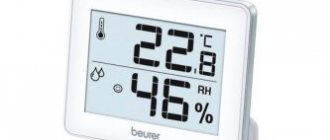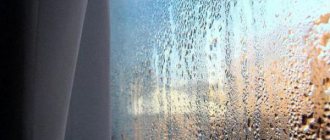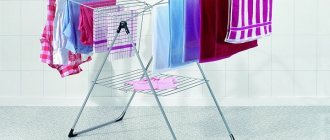Relative humidity is measured in a room - a value indicating the moisture saturation in the atmosphere. To find out the humidity in the house, you need to calculate the percentage of the maximum capacity and the actual amount of moisture. In everyday life, all complex calculations are done in a matter of seconds by special devices.
For interior design, you can use a composite board, as it does not deteriorate in any microclimate. This material consists of wood and polymers; thanks to this composition, this board is widely used in the interior: for terraces, the area around the pool, and interior decoration.
What is air humidity
In molecular physics, air humidity refers to the content of water vapor molecules in the air around a person. One hundred percent humidity is characterized by the appearance of condensation on surfaces. There is precipitation outside at these levels.
Normal humidity in a living space is usually different from that outside. In an apartment it is more stable, while in the environment it changes under the influence of changing seasons - in autumn and spring it is higher, in winter when there is frost and in summer when it is very hot it is lower.
Fluctuations in humidity are caused by temperature. When it is too high, water molecules evaporate, and when it is very low, they crystallize. In a living room, air is most often made dry by central heating radiators.
The effect of humidity on well-being
It has long been noted that people are extremely sensitive to the content of water vapor in their homes. With low or high moisture content in the air, apartment dwellers feel uncomfortable. The most pronounced symptoms are weakness, fatigue, headache, decreased immunity.
When humidity is low, dust accumulates in the air. It creates conditions for the proliferation of tiny dust mites, which contribute to the development of allergies.
A dry microclimate promotes the accumulation of static electricity, which causes tiny dust particles to accumulate in the air. This is an excellent environment for bacteria and microscopic organisms that cause various diseases to thrive.
In such rooms, people often experience dry skin, which leads to dermatitis, brittle hair, and the appearance of early wrinkles. Drying of the mucous membranes contributes to the development of frequent colds, as well as eye diseases.
Due to the slowdown in blood circulation, the load on the heart increases, which can lead to increased blood pressure and ailments of the cardiovascular system.
A humid microclimate in the house is no less dangerous. In this case, favorable conditions are formed for the flourishing of bacteria, the appearance of black mold, and fungi, which form colonies on wet walls.
The harmful substances released by these single-celled creatures can lead not only to the development of allergies, but also to acute poisoning. Its first symptoms are weakness and dizziness.
High humidity negatively affects people’s health, as well as the condition of furniture and household appliances, which quickly break down
A long stay in a damp room threatens the development of all kinds of diseases - from common acute respiratory infections to rheumatism and tuberculosis. With high humidity in living spaces, there is a lack of oxygen, which increases the load on the heart and leads to diseases of this important organ.
It is especially dangerous if the increased level of water vapor is combined with high air temperature, which can trigger heatstroke or even a heart attack.
What does deviation from the norm lead to?
If the average room humidity is significantly higher than normal (more than 20–30%), various problems may arise:
- The appearance of mold. A humid and warm environment is the optimal condition for the development of fungal spores. Mold most often forms in the bathroom, kitchen, and corners of rooms. In children and people with weakened immune systems, it can cause respiratory problems and allergic reactions. For asthmatics, damp rooms are dangerous because prolonged exposure to them provokes frequent attacks.
- Increased heat transfer. In hot summer weather, high temperatures are felt worse when there is an increased content of moisture particles in the air. The result may be overheating or heatstroke.
Dependence of the development of diseases and fungi on the humidity in the apartment
It is the state of health of the residents of the room that determines what humidity should be in the house. Too high is not suitable for asthmatics, allergy sufferers, small children, people with hypertension, cardiovascular diseases and immunodeficiency.
If the humidity level in a room for a person is not met and the air is too dry, this is also harmful to health:
- Dry mucous membranes. This can manifest as itching and irritation of the eyes, especially in people with contact lenses, a sore throat, and a hacking cough.
- Difficulty breathing. When the mucous membranes of the nasopharynx dry out, they do not perform their protective functions. A person becomes susceptible to colds and infections, nosebleeds, chronic rhinitis, and exacerbation of bronchial asthma.
- Deterioration of skin condition. Peeling, irritation, redness, the appearance of wrinkles - all this occurs against the background of a violation of the hydrobalance of the skin. High air humidity has a particularly bad effect on people with psoriasis, atopic dermatitis and other dermatological diseases.
Most unpleasant symptoms do not appear immediately. But if there is no normal humidity in the apartment, sooner or later its residents will begin to experience discomfort.
What are the dangers of dry and humid microclimates?
Residents of individual apartments most often think about the state of the air during the heating season. It is during the cold season, with the windows closed and heating devices running, that discomfort associated with dry air appears. However, excess moisture also has a bad effect on the well-being of the inhabitants of the house, provoking increased allergies, the development of bronchitis, asthma, and other respiratory diseases. The table describes the dangers of dry air and high humidity.
Table - The influence of excess and lack of moisture in the air on human health
| Deviation from the norm | Physical manifestation |
| Flaw | - Peeling, skin irritation; - brittle nails and hair; - inflammation, redness of the eyes; - dizziness, headache; - development of allergy to dust; - weakened immunity, - increased susceptibility to infections |
| Oversupply | — Creation of conditions for the development of fungus; - feeling of dampness; - the occurrence of frequent migraine attacks; - decreased performance; - appearance of lethargy, apathy |
Low humidity has an adverse effect on plants in the house - leaves turn yellow due to dryness and fall off. Wooden products, parquet, and musical instruments become very dry and deformed. Varnish coatings lose their attractiveness.
The norm of air humidity in the apartment
Recommended GOST 30494-96 air humidity in the room depending on the time of year:
- in winter – 30–45%;
- in the autumn-spring period - 30–45%;
- in summer – 30–60%.
Optimal indoor humidity for people of different ages:
- for adults – from 40 to 60%;
- for children under 6 years old – 50–60%.
The ideal air humidity in an apartment for a person varies depending on the purpose of the room:
- in the bathroom, where the ceiling, walls and floor are usually resistant to water, humidity can reach 60–70%;
- normal humidity in rooms reserved for the kitchen, corridors, pantries is 40–60%;
- in rooms where there are plants, the humidity should not be lower than 60–70%, for tropical and subtropical flowers – up to 80–95%, so it is recommended to take them out onto the balcony, loggia or give them a separate room;
- It makes no sense to regulate humidity on a loggia or balcony, since this is a non-residential premises.
According to SanPiN 2.1.2.2645-10, the relative humidity for premises is placed within a more rigid framework and has values of 60% in the cold season, and 65% in the summer. Some rooms are not standardized due to non-constant or short stay in them, as well as frequent and long-term changes in humidity in these rooms
| The name of a room | Air temperature, °C | Relative humidity, % |
| winter | ||
| Living room | 18–24 | 60 |
| Room in the coldest five-day areas (minus 31 °C and below) | 20–24 | 60 |
| Kitchen | 18–26 | N/N* |
| Toilet | 18–26 | N/N |
| Bathroom, shared bathroom. node | 18–26 | N/N |
| Lobby | 14–20 | N/N |
| Storerooms | 12–22 | N/N |
| summer | ||
| Living room | 20–28 | 65 |
* - not standardized
To increase the service life of household appliances, the safety of books, paintings, and upholstery of upholstered furniture, the humidity level should not exceed 60–65%.
Hydrogel beads
How to humidify the air in an apartment in summer? Use a beautiful accessory - hydrogel balls. This substance is a polymer that has high absorbent properties. It is capable of absorbing 100–200 times its own weight in water.
Multi-colored hydrogel balls can be purchased at a flower or hardware store. They are used instead of soil for growing some varieties of indoor plants. If you need to humidify the air at home, do this:
- Select a vessel. Use glass vases to make your handmade humidifier look aesthetically pleasing and fit harmoniously into the interior of the room.
- Place hydrogel beads inside the vase and fill them with water. Under the influence of moisture, the granules first absorb moisture, swell, and then begin to slowly release it to the air.
From time to time, add water to the hydrogel balls so that the evaporation process does not stop.
Normal air humidity in a child's room
The optimal air humidity for a child in an apartment is determined based on his age. Compliance with this parameter is especially important for newborns:
- Features of thermoregulation in infants. The drier the air (which the child inhales), the more fluid the body will spend to hydrate it. This is associated with large losses of water - dryness of the mucous membrane of the nasopharynx and nasal cavity occurs, and it is difficult for the baby to breathe. As a result, he wakes up more often at night, eats poorly, and is capricious.
- Long heating season. In most Russian cities it lasts at least 6 months a year. Central heating radiators can reduce the initial humidity levels in a room by 20–40% or more. Low humidity during the heating season leads to frequent respiratory diseases, chronic rhinitis, and an increased risk of bronchial asthma.
Optimal humidity in a child's room is especially important.
Depending on the age of the child, it is determined what humidity should be in the bedroom. For children in the first year of life, the optimal parameter is 50–70%, for children from 1 to 3 years old – 45–65%, for children over 3 years old almost adult norms are suitable – 50–60%.
Signs of Low Humidity
Rooms with low humidity levels are characterized by some or all of the following symptoms :
- Dry wooden furniture that does not close well;
- Gaps between parquet planks;
- Quickly drying soil in pots with indoor plants;
- Increased static electricity;
- The smell of dust from drapes and curtains;
- Difficulty ironing clothes and bed linen;
- Dry skin and brittle hair .
Dry air in living rooms can cause serious illnesses . At first, a person experiences only a feeling of thirst and slight discomfort. These symptoms are replaced by fatigue, burning eyes, drowsiness, and poor appetite.
Over time, the body’s water balance and the protective functions of the mucous membranes are disrupted, and immunity is sharply reduced. Allergic reactions to dust can develop into chronic diseases of the bronchi and lungs.
Doctors' recommendation: regular water procedures, quenching thirst with clean still water, moisturizing the mucous membranes of the nose and eyes will help cope with the unpleasant symptoms of low air humidity.
How to measure humidity
Relative humidity in the room is measured using special devices - hygrometers. They have different designs and operating principles:
- Electronic. Usually combined with thermometers to simultaneously measure room temperature. In them, a thin layer of electrolyte is applied to the inner plate, through which voltage passes. The results are displayed on the indicator panel.
- Mechanical. Cheaper and easier-to-use instruments, however, can produce measurement errors of up to 8%. They operate without a power source and are available as tabletop or wall-mounted. They do not have a digital display, but are equipped with a dial and arrow.
Electronic hygrometers have good accuracy and are affordable.
There are many ways to determine the saturation of air with moisture, not all of them are popular, but there are:
- Weighted or absolute. It is a device that determines relative humidity by absorbing it. Using special tubes with a chemical composition, he takes measurements. Do not use in domestic conditions.
- Hair. This type of hygrometer is used only in laboratories, and only because its operating principle is based on the study of human hair.
- Film. Also belongs to the category of laboratory instruments. The main mechanism is a special film, which, depending on the level of humidity, stretches or, conversely, contracts. It is most effective to use it in the winter season.
- Electronic. This type of device is most often purchased for household humidity measurements. It is quite simple to use, since the mechanism immediately displays the final measurement result on the touch screen.
- Psychometric. The most accurate type of moisture meter. Often it is purchased for work in production and laboratory premises. Also, many “civilian” users choose psychometric hygrometers because of their comparatively low cost and extreme accuracy.
To determine the standard air humidity in an apartment, an inexpensive mechanical hygrometer is suitable. For domestic use, certification by the metrological service is not required.
It is important to pay attention to the temperature range of use - the maximum value is 80–120 degrees. When used in a sauna or bathhouse, you must choose the extreme option.
Determining humidity without instruments
You can independently find out quite accurately the air humidity in the room without having any instruments. There are two options for this.
When measuring using the first method, you need to measure the air temperature in the room with a thermometer and record the readings. Then take a small piece of cloth or bandage, wet it and wrap the tip of the thermometer and leave it for about 5 minutes. Next, having calculated the difference in readings (subtract the smaller from the larger), you need to use a psychrometric table.
Psychometric table for determining relative air humidity
In the second case, you need to pour a glass of water and cool it in the refrigerator to +3...+5°C. After this, move the glass to a room away from heating devices and leave for 10 minutes. We look at the glass if:
- The glass is dry. The humidity in the room is insufficient.
- There is condensation on the walls. The humidity is fine.
- Large condensation and drips. The humidity is too high.
Increased condensation on a glass with drips indicates increased humidity
Installation of humidity control sensors
In order to constantly monitor the level of humidity in the apartment, you should install humidity sensors at home. These are the same hygrometers, but more accurate and modern. Most of them work through certain electronic or mechanical means that respond to changes in the level of the indicator in the apartment.
The most accurate is an optical hygrometer, which is focused on determining the dew point temperature of a gas.
Other humidity sensors are intended primarily for industrial and agricultural use.
These include capacitive, the operating principle of which is built around condensation - the higher the humidity, the larger the capacity. Some climate control systems have built-in hygrometers of varying degrees of accuracy, so in some cases they may be preferred over sensors. The advantage of sensors is their accuracy, autonomy and wide space coverage.
The health of all residents, as well as the condition of household appliances, furniture and any other household items, plants and pets, is affected by air humidity that is comfortable for humans. At the moment, there are many devices that can accurately measure and effectively correct microclimate indicators.
Article design: Vladimir the Great
How to increase air humidity with household appliances
The most affordable and popular device for increasing humidity in the air is a household humidifier. It can be used all year round, but it will be especially useful in winter, when indoor humidity of 20 percent causes discomfort.
The following types of humidifiers are available:
- Classic. The operating principle of such devices is based on the evaporation of cold water without preheating. Water flows from a special container onto the evaporator - disk, filter or cartridge. Due to the fact that such devices take air from the room and release it after cleaning with a filter, additional removal of dust and allergens occurs.
- Humidifiers with air purification function. These are full-fledged climate control devices that simultaneously increase the level of humidity and purify the air by equipping them with special replaceable filters. They are also called air washers.
- Steam models. The operating principle of such devices is similar to the operation of an electric kettle. Heating elements with a ceramic plate or coil release steam after preheating the water. It is optimal to use both in summer and to maintain humidity levels in the apartment in winter.
- Ultrasonic. The most expensive and effective. The liquid poured into the reservoir flows onto a plate that vibrates under the influence of ultrasound. The water breaks up into tiny droplets, which enter the room through a cooler inside the case.
Air humidifier with cleaning function (air washing)
Steam humidifier
Ultrasonic humidifier
With the help of such devices you can not only create comfortable humidity in the apartment, but also regulate other parameters:
- control temperature;
- neutralize pathogenic microbes;
- trap dust and allergens.
The action of a humidifier can cover different areas, which must be taken into account when purchasing. Small household appliances are suitable for the bedroom or kitchen. For a living room or other larger rooms, you need a powerful device.
Aquarium
Any container of water helps to humidify the air. It should be left in the room and the liquid will gradually evaporate.
If a bowl of water in the house does not look entirely appropriate, then an aquarium will be a real find. Here are a few rules that ensure the room is humidified by using an aquarium:
- Do not cover the aquarium with a lid.
- Clean the vessel periodically and change the water in it.
- Install a pump with a fountain in the aquarium. This will enhance the moisturizing effect.
Having an Aquarium at Home Increases Humidity Levels: Pexels
How to increase air humidity using folk remedies
Air humidity in a dry room can be increased using traditional methods:
- regular wet cleaning;
- frequent ventilation (not in sub-zero temperatures), especially after rain;
- installation of a mini fountain, aquarium or other water containers;
- growing flowers and watering them regularly;
- reducing the intensity of heating radiators using wet towels;
- using a spray bottle.
Folk remedies to increase the humidity in the room
To increase the humidity in the room, you can dry clothes directly indoors, and not on the balcony or street. When cooking food, water vapor from boiling pots also enters the air.
What affects the microclimate
Humidity is a value that depends on the following factors:
- Ventilation - the better the ventilation of the room is organized, the better it maintains a normal level of humidity. Ventilation stabilizes the indicator to a natural level, as it helps remove excess moisture from the room and purify the air.
- Heating means - batteries, radiators, stationary heating means - the warmer the air, the drier it is.
- Means for optimizing the microclimate - air conditioners, humidifiers, climate control and other devices that can humidify the air. This is especially true for air washers, which are equipped with devices for multi-stage air purification. Air conditioners, on the contrary, dry the air due to the fact that excess moisture condenses.
- All household procedures related to water - cleaning, cooking, washing - contribute to air humidification.
- Time of year and outside temperature - the warmer the air, the drier it is. Therefore, the humidity standard in GOSTs has an error for the warm and cold seasons.
- The layout of the apartment, sealing materials (plastic windows, sound insulation, etc.) affect humidity. The more sealed the room, the worse the ventilation in it, and accordingly, the drier the air there.
Air humidity that is comfortable for a person can be arranged in an apartment by knowing the factors that influence the level of air dryness.
How to reduce humidity
High humidity is not always a good thing. If mold, mildew appears on the walls, or condensation constantly collects, it must be reduced. You can use one of these methods:
- Dehumidifiers. Special devices absorb excess water molecules, taking air from the room. The principle of operation of such a device is based on the condensation of steam in the room. The air conditioner performs part of the functions of a dehumidifier - it also takes water from the air.
- Good ventilation. Clogged air ducts do not cope with the function of removing excess wet air from the apartment.
- Drying clothes outside or on the balcony. When drying, the fabrics release water molecules into the air, which circulates throughout all rooms and increases humidity.
- Sunlight. When it enters a room, it causes water to evaporate, so it is recommended to open windows regularly.
Some factors that increase humidity cannot be influenced:
- the more people live in an apartment, the lower this figure will be;
- if all the windows face north, the rooms most often have dampness;
- In some cities, climatic conditions determine constant high humidity.
Units
Humidity can be relative or absolute. In scientific works the absolute value is indicated. It is measured how many grams of water vapor are in 1 m3. At a certain temperature, air can hold a limited amount of water. This is called maximum moisture content.
Room air quality
Absolute humidity is difficult to measure, so relative humidity is more often used. It determines how much water vapor is in the air compared to the maximum possible amount. This is the degree of its saturation with moisture, shows the result as a percentage.











